
| Soviet M38 All content copyright © 7.62x54r.net Return to Models Introduction |
Overview
In 1938 a carbine was adopted as the "7,62 mm Carbine, Model of the Year 1938", commonly known as the M38 in the US, but did not go into production until 1939. It is essentially a shorter version of the M91/30 and was built at Izhevsk until 1945. There was limited production at Tula in 1940 and again in 1944. Both arsenals built some M38s on recycled receivers, both hex and round. Tula M38s are uncommon at the least and sought after by collectors as are 1939 and 1945 dated examples. The M38 was not designed to accept a bayonet since it's intended use was by rear area troops. Stocks made in 1939 and early 1940 had the rear barrel band shoulder close to the rear sight base but this was soon moved forward to bring the pattern in line with the typical M91/30 stock configuration, with the exception of the fore-end.
Variations and Features to Look For
Although the M38 was only in production for a relatively short time and was used primarily as a second line defensive weapon it has some interesting and uncommon variations which are sought after by collectors. A brief summary of these follows.
Arsenals and Dates M38 production began at Izhevsk in 1939 and continued through 1945. The first and last years of production are uncommon and typically bring a premium. All other years are relatively common, but eariler dates are tougher to locate than later ones. Tula only made M38s during two years, 1940 and 1944. Examples dated 1940 from Tula are rare and 1944 Tula M38s are not common and should be acquired when found at the price of a similar condition Izhevsk. No rifles from other arsenals or years were cut down and converted to actual M38s. Any carbines outside of the arsenals and dates listed here are another model, most likely an M91/59 or M91/38, which are covered on their respective pages.
Receivers By the time the M38 went into production the round receiver had been standard for several years so none were ever built on new hex receivers. However, some were built on older hex receivers from rifles which presumably had barrels which were damaged or worn. Examples from Izhevsk are uncommon with only a handful reported. Tula M38s on hex receivers are more common than Izhevsk examples, but the reported numbers are still very low, less than a few dozen. There are also Tula M38s on older round receivers, but because this is not as readily apparent there is not a good idea of the number of these. It would be reasonable to assume it's comparable to the number of hex Tula M38s. Regardless, any M38 from either arsenal on a non-standard configuration receiver for it's year of production is uncommon and should be acquired if for no other reason than as trading material with other collectors who have an interest in that type of variation.
Stocks M38 stocks come in six primary types as pictured below on this page. Any of the stock types can be found on any date M38 due to the refurbishment process where stocks were replaced or reused on other rifles. The very first stocks from 1939 and part of 1940 have the rear barrel band set close to the rear sight with a corespondingly shorter rear section on the handguard. Due to attrition during WWII these are very uncommon to find and should be purchased when they are encountered, especially if there is no premium price attached. In early 1940 the rear barrel band was moved forward to bring the configuration more in line with the M91/30 stock, with the exception of the fore end length of course. Both of these early stocks have sling slot escutcheons which are held on with two small screws each. The second pattern with the early escutcheons are not particularly rare, but are a minor "bonus" on earlier rifles, and even later ones, although obviously not original. During WWII the rear sling slot escutcheon was eliminated and the front one was converted to a sheetmetal liner in the bottom of the slot only to save material and labor in production. This is the most common of the true M38 stocks among recent imports, but less common than M44 type stocks. Post war M38 stocks have full escutcheons both front and rear but they are pressed into the stock rather than screwed on. These are replacement stocks but are uncommon to find in M38 configuration (no M44 bayonet groove) and would be of interest to anyone who focuses on M38s. Laminated M38 stocks began to be produced late in WWII and are much less common than solid or "hardwood" stocks and do bring a premium. There are two types of laminations (see pictures below) with the early indistinct pattern being much less common than the later distinct pattern. All stock types can have a variety of repairs and most don't bring a premium or hurt the value of a rifle. M38 stocks with the distinctive "zig zag" splice just behind the rear barrel band or in the fore end as found on a few M91/30s have not been reported so they would be an interesting find. M38s are commonly found in any of the M44 stock types and none are particularly rare or desirable. In fact, many collectors spend a fair amount of time seeking out M38s that are not in M44 stocks. M38 handguards don't have much variation, other than the very early ones which are only found with the correct stock, except in the type of material used for the end caps. Brass was used briefly and the majority are steel which is found on most rifles today. Any of these can be covered with black paint from the refurbishment process so it pays to look close if you are in the market for a brass capped handguard.
Sights and Barrel Bands There were only minor changes to M38 sights throughout production which are detailed below but don't mean much as far as value or rarity are concerned. Likewise the split barrel bands did not change, but occasionally an early "button band" may be found on an M38. While uncommon, they are incorrect and don't really add much value to the carbine.
Marks There are a wide variety of unknown marks found on M38s with the Soviet MO double and triple dates being among the more desirable. Marks associated with particular countries are covered below. Due to heavy reworks and sanding during refurbishment clear arsenal marks are seldom found on M38 stocks and are a nice bonus. On the other hand, there are numerous Cyrillic letters and numbers found alone or in circles, squares, and triangles with unknown meanings which don't add any value other than as a curiosity.
Other Countries Soviet M38 carbines were also used by a number of
different countries and can often be identified by additional marks or simply
conditions and features unique to these countries. In general these are less
common, more desirable, and more valuable than typical Soviet refurbished
rifles. No other countries built their own M38s and any apparent non-Soviet M38,
especially from Poland, Hungary, Romania, or China, is likely an M44/T53 with
the bayonet lug removed. The value of these is neglible to collectors.
Finland Finland captured a number of M38s during the Winter and
Continuation Wars. The best known identifier is the SA mark
typically found on the left side of the barrel along the woodline, although
occasionally in other locations on the barrel shank. Other
Finnish marks include a
"D" which indicates the chamber throat has been enlarged for the
Finnish D166 cartridge and is sometimes the only indication an M38 has a Finnish
history. Stocks on these are typically Soviet with no known Finnish made M38
stocks. Miscellaneous parts and
features can vary greatly due to the number of early parts on hand in Finland used
for repairs, but a number of Finnish M38s are in surprisingly original matching
condition. They are certainly a "must buy" when sold at the going price
for Soviet refurbs and tyically bring four to six times as much.
Germany While Germany almost certainly captured M38s during WWII they did not typically mark them in any way and any "German or Nazi marked" M38 found
on the US market should be viewed with great suspicion considering the
proliferation of fake German stamps. There are
East German marked M38s, but these were
provided by the Soviet Union during the Cold War and subsequently returned to
the Soviet Union where they were refurbished and later exported among the
thousands of other carbines. A few of these have a dark, almost brown, finish to
the stock and atypical sling slot escutcheons which may be from an East German
refurbishment program.
Romania A very few M38s have shown up with Romanian "INSTRUCTIE"
marks, but they should be considered uncommon and purchased in spite of the
typically poor condition as long as the price is reasonable.
Burlgaria M38s have been documented with the Bulgarian post WWII pinecone
stock mark and with painted rack numbers on the stock. These are not very well
known and an underappreciated variation.
Egypt and other Arab countries M38s with
Arabic numerals painted on the stocks are known and most are thought to have
come from Egypt. Syria, which was once united with Egypt, is another
possibility. They are uncommon and an interesting Cold War carbine.
Condition, Originality, and Serial Numbers Just as with any collectible item, condition and originality are very important. Ironically some of the most original M38s seen in the US have been imported from Finland. As mentioned above the Finnish M38s can have a mix of parts, but some are virtually untouched other than the SA mark. The common recent M38 imports from Ukraine have all been refurbished during the 1960s/1970s, whether they have a "refurb mark" or not, and therefore lack a good bit of originality. However, some are "more original" than others. Replacement stocks, covered in detail above, are something of a detriment as are renumbered parts. This can be offset by uncommon marks or other features, but when selecting an M38, all else being equal, the more original the better. Serial numbers should be examined closely to determine if they are orginal. Some obvious signs that they are not is a parts mark from an arsenal other than the one the rifle is from, signs of grinding off of an old number, the presence of an old number which is struck through, electropenciled numbers, and the absense of the two letter prefix. Even some stamped marks on "clean" parts from the correct arsenal with the full prefix are not original. In this case the font of the letters and numbers should be closely compared to the ones on the barrel. If they are not exactly the same, then they are not original.
Import Marks Obviously a firearm without an import mark is more desirable than one with an import mark. While import marks are a fact of life under current US law that must be accepted there is a great range in the subtlety of marks from different importers. Some collectors simply will not accept a firearm with a large garish mark, but a hard and fast rule against them can rule out some interesting carbines. A subdued and inconspicuous mark is always better, but there are many more important things to consider when buying a firearm.
Barrel Condition and Price These are outside the scope of this article but are covered briefly here.
| Click on the images below for M38 shirts | |||||
 |
 |
 |
 |
 |
 |
| Specifications For all models see the Mosin Nagant Rifle Specifications page. |
||||||
| Weight | Over All Length |
Barrel Length |
Stock Length |
Groove Diameter |
Sight Radius |
Cleaning Rod Length (approx.) |
| 7 1/2 lbs. 3.4 kg. |
40" 101.6 cm. |
20 1/4" 51.4 cm. |
36 1/2" 92.7 cm. |
.311" | 16 1/2" 41.9 cm. |
17 1/2" 44.5 cm. |
| Years of Production by Arsenal For all models see the Mosin Nagant Rifle Years of Production page. |
|
| Tula | Izhevsk |
| 1940 and 1944 | 1939 to 1945 |
| Barrel Markings The dates below the pictures are when the marking was used. The pictures are representative and may not reflect actual dates for this model. |
|
Tula 1940 and 1944 |
|
| Receiver Tang Markings The pictures are representative and may not reflect actual dates for this model. |
|
Tula Star and date |
Izhevsk Arrow in Triangle and date |
| Stock Variations See the Mosin Nagant Rifle Soviet Stock Feature Relationships page for details on stock variations. | |
| 1st pattern stock rear barrel band shoulder close to rear sight |
 |
| 2nd pattern pre-war stock rear barrel band shoulder moved forward to same distance from buttplate as M91 and M91/30 stocks |
 |
| War-time stock |  |
| Post-war stock uncommon in an M38 pattern (no M44 bayonet groove) |
 |
| 1st pattern laminated stock small indistinct laminations |
 |
| 2nd pattern laminated stock large distinct laminations |
 |
| M38s may also be found in any variation of M44 stock. | |
| Other Country's Variations Follow the links for detailed information on each rifle. | |
| Romanian Cold War era Instructie M38 |
 |
| East German Cold War era refurbished Soviet M38 |
 |
| Bulgarian marked Soviet M38 |  |
Receiver Variations See the Mosin Nagant Rifle Receiver Variations page for a detailed comparison of secondary receiver features. |
|
Round low wall receiver |
|
Round high wall receiver |
 |
| M38s, especially from Tula, may also be found built on reused older hex and round receivers. | |
| Cleaning rod nut, tapered hole in front only, hole in top threaded to receive nose cap screw to aid in removing nut | ||
| Nose cap |
| Sling slots | Front | Rear |
| Pre WWII | 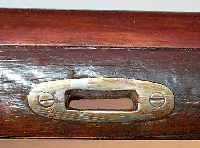 |
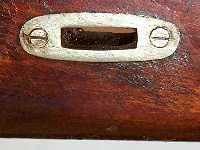 |
| Early WWII | 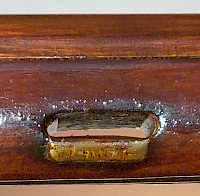 |
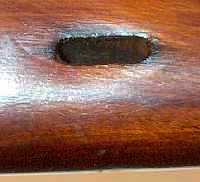 |
| Late/Post WWII | 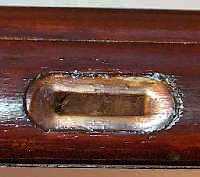 |
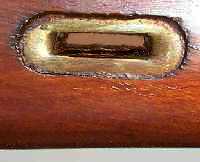 |
| Barrel Band |
| Handguard |
| All content copyright © 7.62x54r.net Return to Models Introduction |